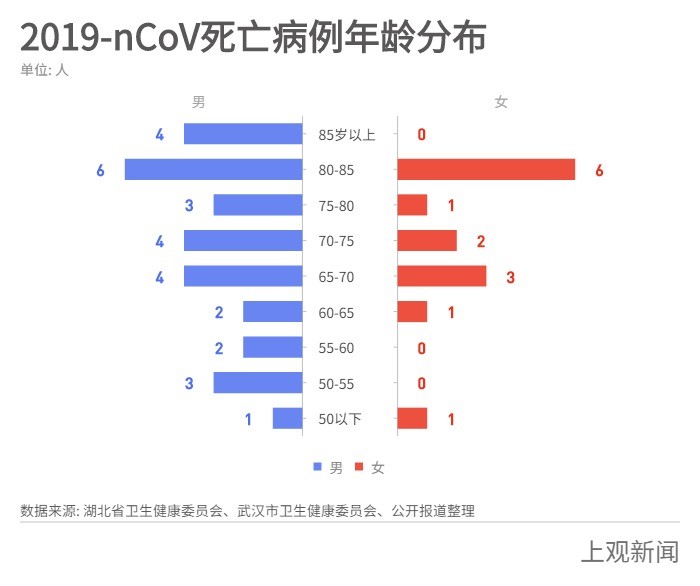Command Palette
Search for a command to run...
After Analyzing Nearly 9,000 COVID-19 Cases, the Largest Dataset to Date Has Been Made Public

In the more than one month since the COVID-19 outbreak, we have been constantly learning more about the virus. On February 11, researchers from multiple scientific research institutions published a clinical retrospective research paper on the virus based on a study and analysis of 8,866 cases, and drew some important conclusions.
As of press time, there have been 59,885 confirmed cases of novel coronavirus pneumonia, and 16,067 suspected cases.
Recently, researchers from the Institute of Microbiology and Epidemiology of the Academy of Military Medical Sciences, Peking University, Chinese Center for Disease Control and Prevention, University of Florida, and other institutions have conducted a 8,866 cases reported from 30 provinces, autonomous regions and municipalitiesAn analysis was conducted and some important conclusions were drawn about the new coronavirus.

The study pointed out that compared with SARS-CoV, 2019-nCoV has similar infectivity and a lower CFR (case fatality rate). Based on personal monitoring data, the researchers emphasized the importance of early detection of elderly patients (especially male patients) before symptoms develop into severe pneumonia.
Note: When the paper was uploaded, the International Committee on Taxonomy of Viruses had not yet named the new coronavirus "SARS-CoV-2", so this article uses the temporary name "2019-nCoV" previously recommended by the World Health Organization.
This study is consideredThe largest retrospective clinical study of the new coronavirus to date.We have sorted out the key points.
Middle-aged and elderly people are more likely to be infected, and the mortality rate is higher in men
The study involved 8,866 cases, including 4,021 (45.35%) laboratory-confirmed cases and 4,845 suspected cases.
The study found thatPatients aged 50 years and above accounted for 47.7%, nearly half of all research samples.
In addition, for these 8866 cases,The overall case fatality rate is estimated to be 3.06%(Confidence interval is 2.02%~4.59%), which is lower than 9.2% of SARS-CoV and 34.4% of MERS-CoV.
Among the confirmed patients,Male patients are three times more likely to die than female patients—— 4.45% (confidence interval 2.81%~6.93%): 1.25% (interval 0.43%~3.29%).

However, the authors remind us that due to data bias (they limited the study sample to patients who had symptoms at least 10 days before January 26, which may have resulted in underdetection and underreporting of mild patients), the overall mortality rate estimated here may be too high, and their estimated mortality rate should be regarded as an upper limit.
On average, one person infects 3.77 people, which is higher than previously reported data.
As a necessary input for estimating the R0 value (basic reproduction number, that is, the average number of new infected people each infected person is expected to transmit), the researchers estimated the distribution of incubation periods from 125 patients with clear exposure times.
Finally, the estimated R0 of this study was 3.77 (confidence interval 3.51~4.05).That is, on average, one infected person is expected to spread the virus to 3.77 new infected people., higher than the data in other previous reports.
R0 estimates under different variable settings before January 1, 2020
Given the significant delay in early diagnosis,The R0 = 2.0 estimate based on 425 early reported patients is likely an underestimate.Of course, another previous estimate of R0 = 2.7 was also based on surveillance data, but using a different method.
The methods reported here allow for the proper detection of infections at later stages of the study period, when symptoms may not yet be present, which is important given the continued growth of this epidemic.
Additionally, this analysis distinguishes between patients who lived and were diagnosed in Wuhan and Wuhan residents who were diagnosed outside of the city, which is the main source of bringing the disease to other parts of China.
The mortality rate of severe pneumonia is higher in patients over 60 years old
Among the confirmed patients,935 cases (25.5%) and 2563 cases (69.9%) were diagnosed with severe and mild pneumonia, respectively.And 167 cases (4.5%) did not suffer from pneumonia.
The age of patients diagnosed with severe pneumonia (mean ± SD, 55 ± 15 years) was significantly older than that of patients with mild pneumonia (45 ± 15 years, 52.71% males) and non-pneumonia patients (42 ± 16 years, 52.1% males), among whom 61.5% were males.
The observed CFR value of patients with confirmed severe pneumonia was 5.88%,It was significantly higher than mild pneumonia (0.12%) and non-pneumonia (0%). In addition, patients aged 60 years and above showed a higher CFR (5.30%) compared with younger patients (1.43%).

Data source: Hubei Provincial Health Commission, Wuhan Municipal Health Commission
Further stratified analysis of multiple baseline variables revealed that patients who met any two of the following three characteristics:Male, over 60 years old, diagnosed with severe pneumonia,The case fatality rate increased further. Especially among elderly male patients diagnosed with severe pneumonia,The adjusted case fatality rate was as high as 9.47%.
The study may have limitations
Finally, the researchers mentioned some possible limitations of this study, such as the failure to include changes in certain disease characteristics due to time constraints.

Data source: Dingxiang Doctor
During the study, the team observed that the curve of the number of confirmed patients per day showed an exponential growth, and the slope was also higher than the data trend before January 25. This suggests that the study may be underestimated.
for example,After early January, the effective reproduction number Rt showed a downward trend.Or it may be because some symptomatic cases have not yet been reported to the CDC, which does not mean that the virus's ability to spread has been reduced.
Therefore, more follow-up studies are needed to assess the transmission ability of the new coronavirus to assist relevant authorities in making decisions on restrictive measures such as travel bans.
In addition, the situation of asymptomatic infections is also worthy of attention.
According to reports, a young woman who returned to her hometown in Henan from Wuhan never showed any symptoms of infection and was suspected to be the source of infection for three confirmed relatives with no travel history to Wuhan.
At present, it is still necessaryThrough contact data tracing and modeling, the transmission capacity of asymptomatic infection and its impact on the overall epidemic can be further assessed.
-- over--


